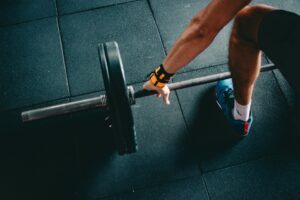 Developing a workout plan can be complicated when you’re unsure of the muscle group you want to target. Most people aim to build muscle in the arms, legs or chest, but they’re not the only important parts of the body. The shoulders, glutes and hamstrings should also be prioritized, and the best way to do it is to create a full-body workout.
Developing a workout plan can be complicated when you’re unsure of the muscle group you want to target. Most people aim to build muscle in the arms, legs or chest, but they’re not the only important parts of the body. The shoulders, glutes and hamstrings should also be prioritized, and the best way to do it is to create a full-body workout.
Training the entire body has numerous benefits, from helping you lose weight to getting in shape. Long-term workouts for all the muscle groups can reduce fatigue and enhance flexibility. However, despite their advantages, recovering might take a lot of time, so you must reduce their frequency or alternate them with cardio workouts and stretching sessions.
Still, if you’re interested in building a full-body workout, here are some things to consider.
Try out compound exercises
Compound exercises target multiple muscle groups simultaneously as part of a full-body workout, which can help you reach your goal faster. For example, squats work on the quads, glutes, and calves, while a kettlebell swing is good for the core, hamstrings, and quads.
Compound exercises ensure overall muscle development by causing the mechanical tension, muscle damage, and metabolic stress needed to build muscle. At the same time, compound training can increase your heart rate, training it to move oxygen and blood to the muscles efficiently.
While going to the gym is what most people do for these exercises, you could make it a home workout with the right equipment. For example, you could get a rope pull machine and use it to improve endurance and cardiovascular health.
Go outdoors
If you have a nearby park with some workout equipment or the space around the house to create it, try working out outdoors. You won’t have trouble with high indoor temperatures. A full-body workout is also doable on boxes, benches, or deck chairs.
For instance, a great exercise is a wide-grip inverted row beneath a bench or picnic table. Alternatively, you could do pull-ups with a tree branch, but make sure it can withstand your weight. Dips, on the other hand, can be done on boxes, benches, or deck chairs. You can also try assisted reverse lunges in the exact location.
A split squat jump is an exercise that requires no other equipment. It is most effective when you multiply the reps. It’s also a great cardio training exercise and can be used towards the end of the workout.
Don’t overo it
A full-body workout should not exceed 60 minutes, especially when you’re a beginner. The intensity of these sessions will leave you drained, but you need time for recovery so the muscles can withstand another round after a few days. Ideally, you train three times a week to be able to relax and recover between the sets. Remember to always stretch before and after the workout to enhance recovery.
An example of such a workout would include the following:
- Squats;
- Bench press;
- Barbell row;
- Upright row;
- Skull crushers;
- Dumbbell curls;
- Leg curls;
- Ab wheel rollout;
Of course, there are many other alternatives to this training session, as you can also do deadlifts, planks or cable triceps extensions, but it’s advisable to find the balance between sets, reps and recovery days.
Learn the effects of exercise on the body
If you want to focus on specific body parts, you should research the benefits of each exercise because some are more efficient than others. Combine the workouts that help you reach your goal.
For example, dumbbell lunges target the lower body more than the upper body, especially the quads and glutes. It ensures you can work on coordination and stability while increasing strength. Remember always to keep your feet a little bit wider apart to be more stable.
On the other hand, standing ab twists will strengthen your core and focus on establishing rotational functional movement patterns. To make the workout efficient, push yourself to touch the knee with the elbow.
Face pulls are also great as part of a corrective movement pattern because they improve posture and activate muscles. Upper-body exercise will solve muscle imbalances and stabilize all muscles.
Full-body workouts also benefit the mind
Besides working on the body, workouts that make you shredded will also make you feel better psychologically. Doing them regularly triggers the release of “feel-good” chemicals that reduce anxiety and symptoms of depression. Full-body workouts can also relieve stress and boost your mood.
One of the best things about working out is getting restful sleep. If you had trouble sleeping at night or experienced disruptions during the REM stage before working out, the workouts will regulate your sleeping patterns, so you’ll be able to fall asleep faster.
Finally, complete workouts contribute to productivity since achieving your goals will make you feel fulfilled. That’s why it’s best to do them for the long term, as the results will have a positive impact on your overall mental health.
Risks of a full-body workout
The problem with full-body workouts is that you can easily get injured if you overdo it even slightly. It’s easy to get overwhelmed by wanting to see results as fast as possible, leading you to potential burnout. Overtraining can be pretty dangerous because prolonged exposure can lead to acute fatigue. Still, if you injure yourself, you’ll find that recovery can take up to a few weeks, during which you might be able to do only some light stretching. Therefore, learn to listen to your body and decrease the intensity when you experience unusual soreness.
What do you think about a full-body workout?
Many people choose full-body workouts because they’re simpler to follow and provide results within weeks. At the same time, this type of training focuses on major muscle regions, so you can never actually skip leg day because the workout will also focus on the upper body. So, try compound exercises, learn to rest, and know when to stop overtraining because being healthy is more important than looking shredded.


